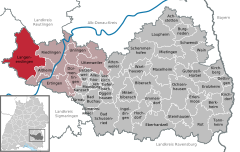Langenenslingen
Langenenslingen
Municipality in Baden-Württemberg, Germany
Langenenslingen (German pronunciation: [ˌlaŋənˈʔɛnslɪŋən]; Swabian: Ẽslenga) is a municipality in the district of Biberach in Baden-Württemberg in Germany. It has a population close to 3,500.
This article has multiple issues. Please help improve it or discuss these issues on the talk page. (Learn how and when to remove these template messages)
|



